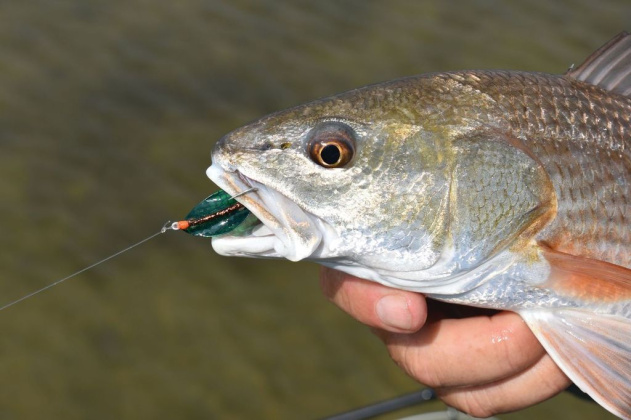
The run across San Antonio Bay from Larson’s Lodge on the Intracoastal Waterway was a trip around islands, through pods of boats harvesting oysters and wide-open expanses of water. Then we came to a small opening in the mangroves along Matagorda Peninsula and we entered a completely different world that few anglers are able to access. About 10 minutes later we eased out of a small channel, barely as wide as the boat and there they were – tails, as in redfish feeding on crabs and small shrimp in the gin clear water of a backwater estuary lake way, way off the grid.
“Pretty cool,” said Capt. Jeff Larson, who runs charters is this hidden paradise on the peninsula, located on the middle Texas coast near the town of Seadrift. “We can clearly see the tails, but it’s up to you to get out, stalk them and drop a fly on one before they spook and blow out.”
I’ve been chasing reds along the Texas Gulf coast for over 50 years, and thought I had seen it all, until Larson turned the key to start his airboat. For six hours we roamed around the backwater lakes that include Fifth Lake, Post Lake, Duck Lake, Power Lake, Bomb Shell Cove and Pecker Head Bay. We saw tailing reds, black drum and a few speckled trout. It was a day of adventure filled fly fishing that is totally out of this world fun.
“I started these spot and stalk trips in the isolated lakes a few years ago,” said Larson. “I had been duck hunting back here and saw plenty of fish. About the slowest time to fish back here is December through March. From April through November we’ve got water that’s warm enough to move fish off the main bays to flats back here with lots of finger mullet, crabs and shrimp to feed on.”
As an angler on these airboat trips you have two options. One is to fish from the boat, or wading. Some of the lakes are boggy and it’s best to stay in the boat. But there are many lakes with shorelines with a firm bottom that allow you to sneak up to within casting distance of fish that you can easily see.
Another option that some adventure minded anglers opt for is to load kayaks into a big shallow running boat that can be maneuvered through the canals. Once you reach a suitable lake you can unload the kayaks and paddle along the edges of mangroves. You won’t cover nearly as much water as you will in an airboat, but it is another way to go. Just don’t forget to mark trails with your GPS. It’s very easy to get lost.
The entire area of water that Larson works is a maze of islands and canals that support flooded black mangroves that stretch for miles.
It’s the perfect water for reds that primarily feed on small crabs, finger mullet and shrimp. The reds and black drum will hit an assortment of flies like weedless bend backs, streamers and poppers. Weedless spoon flies are a very good option. I’ve done real well with a No. 1 or 2 bend back in silver/yellow, silver/ gold or silver/chartreuse. The bend back looks like a crab or shrimp and is a redfish killer.
The most exciting fly you can use for taking reds is a popper. The tiny foam or mylar poppers will get blasted by aggressive reds. Sometimes the only thing that you’ll see is a wake coming up behind the popper, and then a heart-pounding rush of water as the red eats the tiny fly. A No. 2 or 1/0 popper is good. In really clear water the smaller poppers, about the size of the tip of your little finger, are best. But if you’ve got a little bit of wind roughing up the water’s surface a 1/0 popper is best. I’m not so sure that color is a big deal with poppers. But copper or orange is a personnel favorite of mine when chasing reds.
A No. 2 or No. 4 Clouser Minnow is good. It’s a fly that can be bumped along bottom, and will catch both reds and black drum all day long. Best colors are white/yellow and white/chartreuse.
In the shallow back water lakes that Larson fishes a floating/weight forward No. 7 line is best with a 6 to 8-foot leader and 15-pound-test tippet. I like the 7-weight line fished on a 6-weight, 9-foot TFO rod. That’s a good, and well-balanced rig for fishing the smaller flies when you’re catching 18 to 28-inch reds.
For details on airboat fly fishing with Capt. Jeff Larson give him a call at (281) 217-0399, or go to guidefitter.com/larsonslodge.


